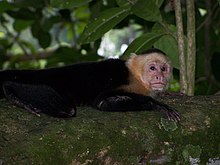Cebus capucinus imitator
| Cebus capucinus imitator | |
|---|---|

| |
| Scientific classification | |
| Domain: | Eukaryota |
| Kingdom: | Animalia |
| Phylum: | Chordata |
| Class: | Mammalia |
| Order: | Primates |
| Suborder: | Haplorhini |
| Infraorder: | Simiiformes |
| Family: | Cebidae |
| Genus: | Cebus |
| Species: | |
| Subspecies: | C. c. imitator
|
| Trinomial name | |
| Cebus capucinus imitator (Thomas, 1903)
| |
Cebus capucinus imitator is a subspecies of the white-headed capuchin.[1] Some authorities dispute whether C. c. imitator is actually a separate subspecies.[2] Other authorities regard it as a distinct species, Cebus imitator.[3] Cebus capucinus imitator ranges from Nicaragua through Costa Rica and part of Panama, west of the Panama Canal.[1] Cebus capucinus imitator differs from C. c. capucinus in that females have elongated frontal tufts.[1] It also differs from C. c. capucinus in the ratio of the width of the upper premolars to the width of the first molar.[4] It is larger than the other possible subspecies of white-headed capuchin, C. c. limitaneus and has a larger skull.[1] However, Boubli, et al, who performed a mitochondrial DNA study of the gracile capuchins which concluded that C. imitator was a separate species, also concluded that C. c. limitaneus is not a distinct taxon from C. c. imitator.[3] In that case, C. imitator would encompass the range of C. c. limitaneus in northern Nicaragua and Honduras.[3]
Refefences
- ^ a b c d Rylands, Anothony B.; Groves, Colin P.; Mittermeier, Russell A.; Cortes-Ortiz, Liliana; Hines, Justin J.H. (2006). "Taxonomy and Distributions of Mesoamerican Primates". In Estrada, Alejandro; Garber, Paul A.; Pavelka, Mary McDonald; Luecke, LeAndra (eds.). New Perspectives in the Study of Mesoamerican Primates. Springer. p. 42. ISBN 9780387258720.
{{cite book}}: Unknown parameter|last-author-amp=ignored (|name-list-style=suggested) (help) - ^ Groves, C. P. (2005). Wilson, D. E.; Reeder, D. M. (eds.). Mammal Species of the World: A Taxonomic and Geographic Reference (3rd ed.). Baltimore: Johns Hopkins University Press. p. 137. ISBN 0-801-88221-4. OCLC 62265494.
- ^ a b c Boubli, Jean P.; Rylands, Anthony B.; Farias, Izeni P.; Alfaro, Michael E.; Alfaro, Jessica Lynch (2012). "Cebus Phylogenetic Relationships: A Preliminary Reassessment of the Diversity of the Untufted Capuchin Monkeys" (PDF). American Journal of Primatology. doi:10.1002/ajp.21998. Retrieved 8 August 2017.
{{cite journal}}: Unknown parameter|last-author-amp=ignored (|name-list-style=suggested) (help) - ^ Smithsonian Miscellaneous Collections, Volume 69, Issue 5. Smithsonian Institution. 1920. p. 232.
